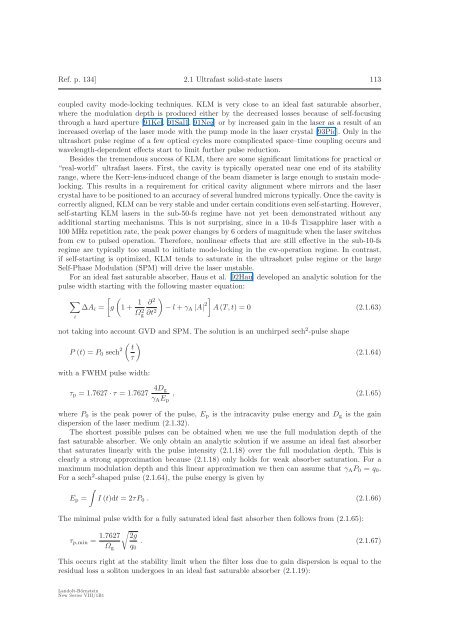2.1 Ultrafast solid-state lasers - ETH - the Keller Group
2.1 Ultrafast solid-state lasers - ETH - the Keller Group
2.1 Ultrafast solid-state lasers - ETH - the Keller Group
You also want an ePaper? Increase the reach of your titles
YUMPU automatically turns print PDFs into web optimized ePapers that Google loves.
Ref. p. 134] <strong>2.1</strong> <strong>Ultrafast</strong> <strong>solid</strong>-<strong>state</strong> <strong>lasers</strong> 113<br />
coupled cavity mode-locking techniques. KLM is very close to an ideal fast saturable absorber,<br />
where <strong>the</strong> modulation depth is produced ei<strong>the</strong>r by <strong>the</strong> decreased losses because of self-focusing<br />
through a hard aperture [91Kel, 91Sal1, 91Neg] or by increased gain in <strong>the</strong> laser as a result of an<br />
increased overlap of <strong>the</strong> laser mode with <strong>the</strong> pump mode in <strong>the</strong> laser crystal [93Pic]. Only in <strong>the</strong><br />
ultrashort pulse regime of a few optical cycles more complicated space–time coupling occurs and<br />
wavelength-dependent effects start to limit fur<strong>the</strong>r pulse reduction.<br />
Besides <strong>the</strong> tremendous success of KLM, <strong>the</strong>re are some significant limitations for practical or<br />
“real-world” ultrafast <strong>lasers</strong>. First, <strong>the</strong> cavity is typically operated near one end of its stability<br />
range, where <strong>the</strong> Kerr-lens-induced change of <strong>the</strong> beam diameter is large enough to sustain modelocking.<br />
This results in a requirement for critical cavity alignment where mirrors and <strong>the</strong> laser<br />
crystal have to be positioned to an accuracy of several hundred microns typically. Once <strong>the</strong> cavity is<br />
correctly aligned, KLM can be very stable and under certain conditions even self-starting. However,<br />
self-starting KLM <strong>lasers</strong> in <strong>the</strong> sub-50-fs regime have not yet been demonstrated without any<br />
additional starting mechanisms. This is not surprising, since in a 10-fs Ti:sapphire laser with a<br />
100 MHz repetition rate, <strong>the</strong> peak power changes by 6 orders of magnitude when <strong>the</strong> laser switches<br />
from cw to pulsed operation. Therefore, nonlinear effects that are still effective in <strong>the</strong> sub-10-fs<br />
regime are typically too small to initiate mode-locking in <strong>the</strong> cw-operation regime. In contrast,<br />
if self-starting is optimized, KLM tends to saturate in <strong>the</strong> ultrashort pulse regime or <strong>the</strong> large<br />
Self-Phase Modulation (SPM) will drive <strong>the</strong> laser unstable.<br />
For an ideal fast saturable absorber, Haus et al. [92Hau] developed an analytic solution for <strong>the</strong><br />
pulse width starting with <strong>the</strong> following master equation:<br />
∑<br />
ΔA i =<br />
i<br />
[<br />
g<br />
(<br />
1+ 1 Ω 2 g<br />
∂ 2 )<br />
]<br />
∂t 2 − l + γ A |A| 2 A (T,t) = 0 (<strong>2.1</strong>.63)<br />
not taking into account GVD and SPM. The solution is an unchirped sech 2 -pulse shape<br />
( ) t<br />
P (t) =P 0 sech 2 τ<br />
(<strong>2.1</strong>.64)<br />
with a FWHM pulse width:<br />
τ p =1.7627 · τ =1.7627 4D g<br />
γ A E p<br />
, (<strong>2.1</strong>.65)<br />
where P 0 is <strong>the</strong> peak power of <strong>the</strong> pulse, E p is <strong>the</strong> intracavity pulse energy and D g is <strong>the</strong> gain<br />
dispersion of <strong>the</strong> laser medium (<strong>2.1</strong>.32).<br />
The shortest possible pulses can be obtained when we use <strong>the</strong> full modulation depth of <strong>the</strong><br />
fast saturable absorber. We only obtain an analytic solution if we assume an ideal fast absorber<br />
that saturates linearly with <strong>the</strong> pulse intensity (<strong>2.1</strong>.18) over <strong>the</strong> full modulation depth. This is<br />
clearly a strong approximation because (<strong>2.1</strong>.18) only holds for weak absorber saturation. For a<br />
maximum modulation depth and this linear approximation we <strong>the</strong>n can assume that γ A P 0 = q 0 .<br />
For a sech 2 -shaped pulse (<strong>2.1</strong>.64), <strong>the</strong> pulse energy is given by<br />
∫<br />
E p = I (t)dt =2τP 0 . (<strong>2.1</strong>.66)<br />
The minimal pulse width for a fully saturated ideal fast absorber <strong>the</strong>n follows from (<strong>2.1</strong>.65):<br />
τ p,min = 1.7627 √ 2g<br />
. (<strong>2.1</strong>.67)<br />
Ω g q 0<br />
This occurs right at <strong>the</strong> stability limit when <strong>the</strong> filter loss due to gain dispersion is equal to <strong>the</strong><br />
residual loss a soliton undergoes in an ideal fast saturable absorber (<strong>2.1</strong>.19):<br />
Landolt-Börnstein<br />
New Series VIII/1B1
















